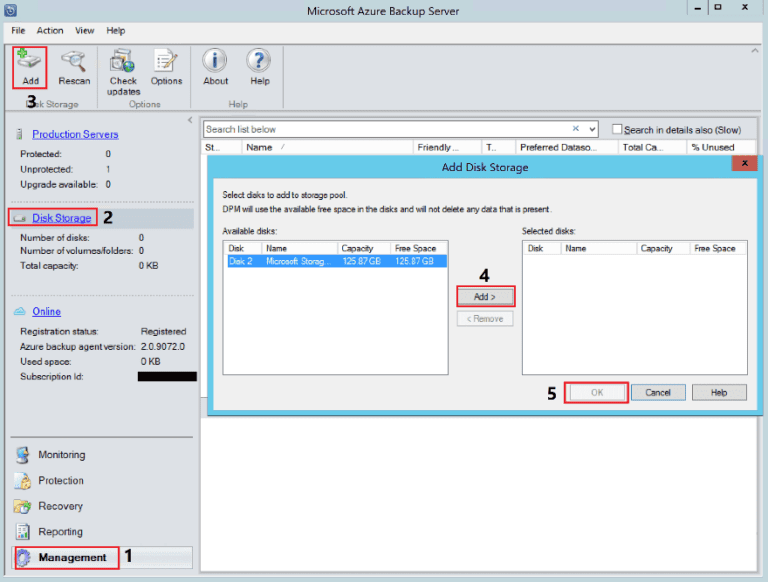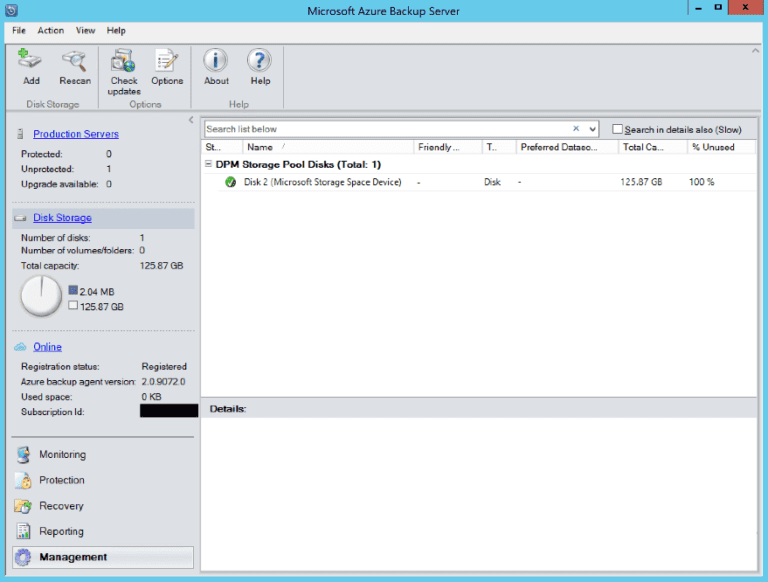Once all the required servers are added you need to create a Protection Group. A protection group allows you to bundle multiple servers together that will have the same backup configuration, including retention, synchronization, and recovery settings. To start, go to the Protection tab and select New.

On the Welcome Screen, click Next. On the next page select either Servers or clients, depending on what you wish to back up.

Next, select all the servers you wish to back up. For each server select the type of data to protect. The choices will be different depending on the server. For Exchange servers, you will be able to select mailbox databases. For Hyper-V Hosts, you will be able to select VMs. For this, I will select SQL databases from one server and System State from another. If you also need to backup any files and folders, you must do so with MABS. You cannot use Azure Backup Agent to backup a server being backed up with MABS.

On the Data Protection Method page, provide a name for this Protection Group as well as method. You can choose either Disk (short term), Online (long term), or both. You cannot choose Online without short-term protection via Disk.

Short term goals determine the retention period to keep the data on the disk. You can also specify an Express full backup for Application backup such as SQL and Exchange. This provides quick recoveries of application data for those platforms.

Disk Allocation shows the size of the data you want to back up based on the prior retention settings. If you do not have enough space, you are provided a warning and are unable to proceed. By default, MABS creates a separate volume for each data source type. You can select Co-Locate data in DPM Storage pool to combine similar resource types in a single volume. Automatically grow the volumes allows MABS to increase the disk size automatically as needed by 25 percent.
MABS does provide the ability to modify the default sizes it will allocate. To do this click the Modify button to review the volumes to be created for this protection group.


Replica creation method determines how you want to generate the initial copy of the backup on MABS. By default, automatically over the network and Now is selected. That will begin the replication of data immediately after the creation of the protection group. We recommend you schedule this during off-peak hours. If the initial replica is extremely large to replicate over your network, you can also select a manual copy. This requires the use of some form of removable or external media to copy the data to MABS.

Consistency Checks are run to check the integrity of the backup point. Keep Run a consistency check if a replica becomes inconsistent checked. You can also setup automatic checks on a schedule. However, these checks can become resource intensive and should be done on off-peak hours. You can also perform a manual check at any time after the protection group is created.

Online Data Protection allows you to choose which data source that your want to provide protection online within Azure. Select one or more of the data sources.

Online Backup Schedule creates the schedule that generates the recovery points on the disk backup. Once created it is transferred to the Azure Recovery Services vault. Again, we would recommend off-peak hours for backups to run.

Online Retention Policy configures how long you wish to retain backup data in Azure. You can select Daily, Weekly, Monthly, and Yearly backups along with the length of retention for each.

Online Replication determines the way to create the initial online backup copy. The default option is over your network. The Offline Backup option creates on offline copy that can be sent to Microsoft using their Import/Export services. This is for very large amounts of data. For more information regarding Offline Backup see https://docs.microsoft.com/en-us/azure/backup/backup-azure-backup-import-export.

On the Summary page, verify the configuration options selected for the protection group are correct and click Create Group. You can monitor the status of the group creation on the Status page. Once complete with Success, click close.


To view the status and configuration of the protection group, select the Protection tab. From here you can modify or delete groups, run consistency checks, pause or resume backups, and other operations related to the backup configurations.

To view the status of the ongoing backup schedule, select the Monitoring tab. From here you can see all alerts, view any scheduled, failed, running, and completed job, or cancel/modify a backup. You can also setup SMTP notifications to send alerts.







































